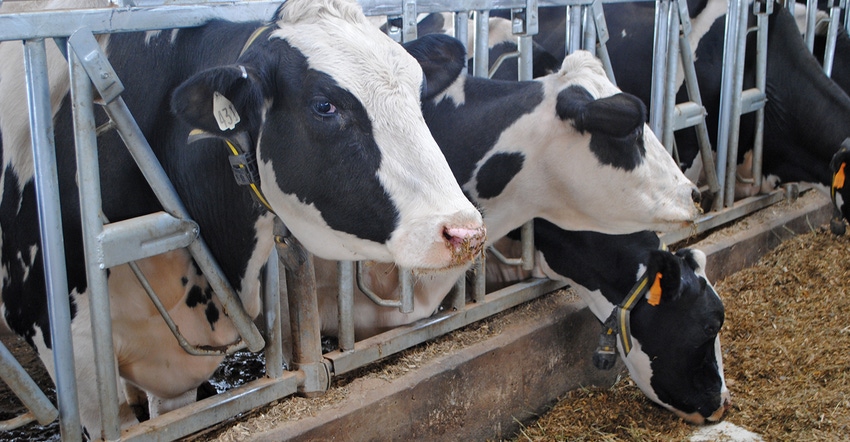January 8, 2018

By Jennifer Blazek
Producing high-quality milk is not the only job of the dairy cow. She spends the majority of her life in your herd, so you are concerned with her most productive years. But what happens when she leaves the herd? When her productive life is over, the second job of the dairy cow is to produce meat.
In Oklahoma State University Extension livestock marketing specialist Derrell Peel’s June 2016 Cow/Calf newsletter, he indicated that dairy cows represent an average of 47% of the total cow slaughter over the last 20 years. Unlike the beef industry, dairy has a more consistent production of animals over time. The number of dairy cows harvested fluctuates from year to year, but it has held relatively steady; in 2015, dairy animals accounted for 57% of total cow slaughter, or about 1.9 billion pounds of beef.
As a cull cow, the dairy cow continues to provide high-quality animal proteins to humans. Even though she leaves your farm, it is you who has the most impact on the quality of meat she produces in the next stage of her productive life. It is important to consider how managing the dairy cow now can affect her later, after she enters the human food chain.
Here are some areas of management to consider while she is in your herd:
• Animal handling. Bruises and other visual quality defects to the meat are more prevalent in cull dairy cows than in cull beef cows, according to the 2007 National Market Cow and Bull Beef Quality Audit. These defects result in a downgraded carcass and reduce the quality of the meat, as the likelihood it will be trimmed and thrown away increases.
Most often, these bruises and other defects are a consequence of poor animal handling. The greatest percentage of the bruises on cows were located on the hindquarters and back legs, indicating handling practices and facility design as the primary cause. Poor animal handling practices decreases the economic value of the carcass.
• Vaccinations. There has been significant improvement in the dairy industry on reducing the incidence of injection-site lesions, but more can be done. According to the 2016 National Market Cow and Bull Beef Quality Audit, 15% of dairy carcasses were found to have lesions, whereas 7% of beef carcasses did.
• Lameness scoring. In 2016, 24% of cull dairy cows displayed some level of lameness, compared to 13% of beef cows, reports the National Market Cow and Bull Beef Quality Audit from that year. Higher incidence of lameness in dairy cows is due primarily to housing, where the majority of cows spend their lives on concrete. Injury and mobility issues are also one of the primary reasons dairy cows are culled from the herd, which increases the likelihood these animals enter the beef market.
• Euthanasia vs. marketing terminal cows. While down cows are not eligible to enter the human food chain, as a producer you can decide when to market terminal cows. Some cull dairy cows should not enter marketing channels due to disease, expected poor-quality carcass or injury. These at-risk cows should be euthanized rather than marketed.
How can a producer address these management areas without making expensive and significant changes to facilities? Educating yourself and your employees about improved management practices is key to ensuring your dairy cows produce high-quality meat as well as milk.
Improving animal handling is one way producers can positively affect the end quality of the cull cow’s carcass. More humane animal handling also improves a cow’s productivity while she is in your herd, leading to more milk and healthier animals. Training is essential for employees to understand what behavior is expected and why it is important. Supervisors, managers and farm owners also need to model the behaviors they expect of their employees to ensure the training is effective and employees have “buy-in.” Connecting improved animal handling to increased animal productivity also helps employees recognize that by changing their behavior, they can also benefit from the returns.
Establishing protocols helps everyone to use best practices when administering drugs and medications to animals. Written and translated protocols that are easy to access and have been discussed with employees are important to ensure everyone is following best practices for animal health. These protocols ensure that injections are given only in the neck, rather than in more valuable cuts of meat, such as the round (hindquarters) or sirloin (between hook and pins). Protocols should include how many injection sites there should be — dependent on the amount of medication to give — as well as proper needle and syringe disposal and handling. Other important protocols to have on the farm include handling of down animals and euthanasia.
If you are interested in any resources about cull cows, contact your county Extension office.
Blazek is the Extension dairy and livestock educator in Dane County, Wis. This column is provided by the University of Wisconsin Extension Dairy Team.
You May Also Like




